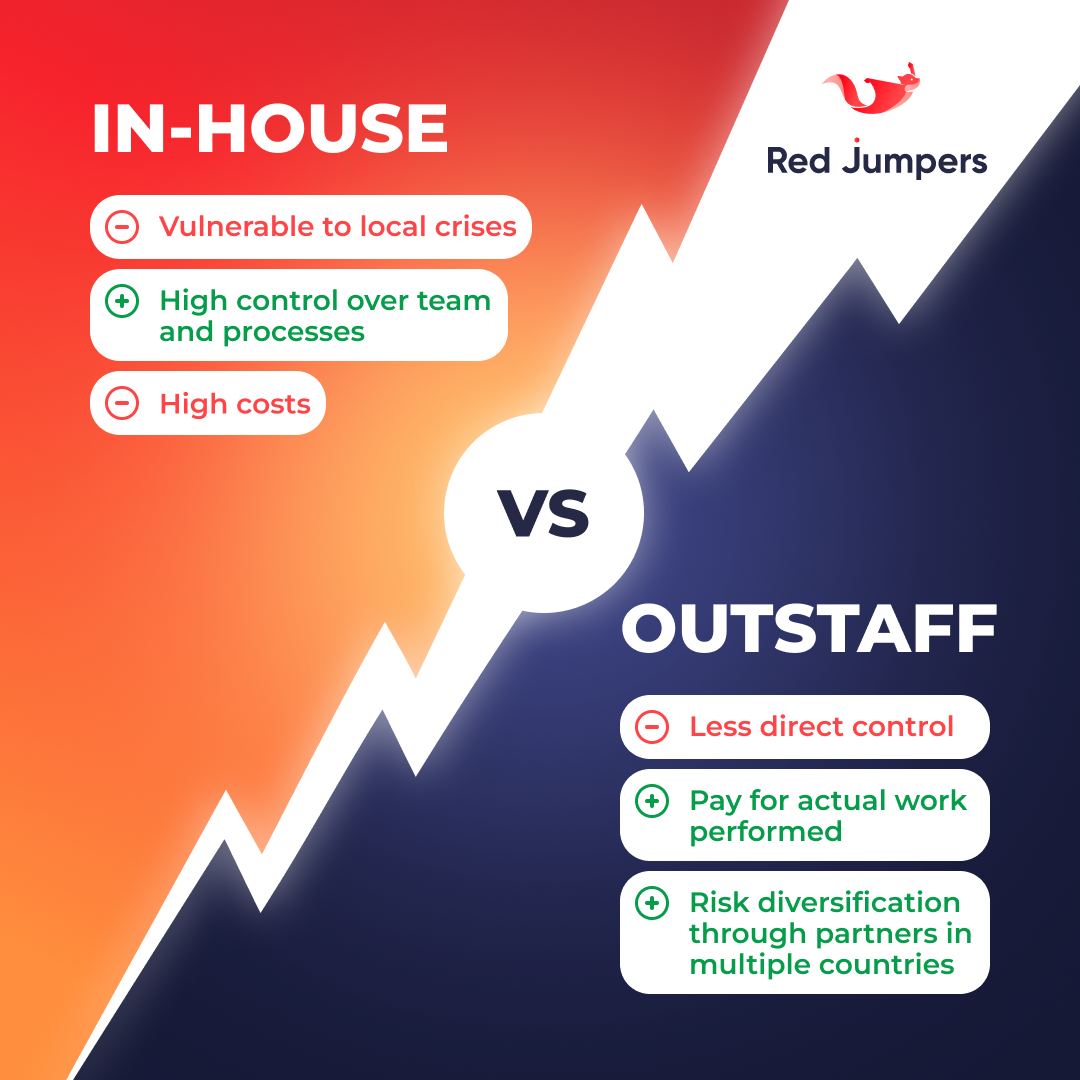In 2025, the competition for top IT talent remains fierce, and companies are rethinking their hiring strategies to stay efficient, agile, and cost-conscious. Two of the most common approaches are in-house hiring and IT staff augmentation. While both have advantages, the key question for many businesses is: Which option is more cost-effective in mid-2025?

In-House Hiring: Stability at a Cost
Bringing talent directly into your team has long been the default choice for companies. An in-house hire offers long-term stability, deep integration into company culture, and full-time availability.
However, in 2025, the total cost of ownership of an in-house employee has increased significantly:
- Recruitment expenses. On average, it takes 1–3 months and thousands of dollars to hire a qualified IT professional.
- Salaries and benefits. Global salary inflation continues. According to recent reports, senior developers in Europe and the U.S. often earn between $90 and $150 annually, plus benefits, insurance, bonuses, and paid leave.
- Training and upskilling. Companies must invest in employee training to keep up with cutting-edge technologies like AI integration, blockchain, and cloud-native systems.
- Retention risks. The average tenure in tech remains short (2–3 years), which means repeated cycles of hiring and onboarding.
In-house hiring makes sense for core roles, where deep institutional knowledge and daily involvement are required. But financially, it’s becoming harder to close every position with in-house employees.
IT Staff Augmentation: Flexibility and Cost Control
Using staff augmentation services, companies can extend their teams with external developers or specialists from trusted vendors, often on a project-by-project or hourly basis.
By mid-2025, staff augmentation became even more attractive due to several reasons:
- On-demand scaling. You can add or reduce headcount to meet the project needs without long-term obligations.
- Access to global talent. Companies can hire skilled professionals from Eastern Europe, Latin America, or Asia at competitive rates, often 30–50% lower than local salaries.
- Reduced overhead. No need to cover benefits, office space, or recruitment costs.
- Specialized expertise. Quick access to niche experts in areas like AI, DevOps, or cybersecurity, without needing to train existing staff.
- Faster time-to-hire. In some cases, a vetted developer can join within days instead of months.
While staff augmentation offers flexibility, the challenge lies in managing remote resources, ensuring cultural fit, and maintaining strong communication. However, with the rise of collaboration tools and experienced vendor management, these barriers are significantly lower today than five years ago.
| Factor | In-House Hiring | IT Staff Augmentation |
| Recruitment Time | 1–3 months | 1–2 weeks |
| Annual Cost per Senior Developer | $90K–$150K + benefits | $40K–$90K (depending on region) |
| Training/Upskilling | Employer’s responsibility | Provided by vendor or optional |
| Flexibility | Low (fixed contracts) | High (scale up/down as needed) |
| Long-Term Retention | Strong (if successful) | Limited (project-based) |
| Overhead | High | Minimal |
Which is More Cost-Effective in 2025?
- For long-term, mission-critical roles (e.g., CTO, product lead, or teams building core IP), in-house hiring is still more valuable. The stability and deep knowledge outweigh the costs.
- For fast-scaling projects, niche expertise, or budget-conscious operations, staff augmentation delivers better ROI. Businesses avoid heavy overhead and can move quickly in competitive markets.
Many companies now adopt a hybrid model: maintaining a strong in-house core team while leveraging staff augmentation for flexibility and specialized skills. This balance helps reduce costs while keeping strategic knowledge internal.
Check out our 2023 article on IT Staff Augmentation to see how the trends have shifted since then.
Conclusion
In mid-2025, staff augmentation is generally more cost-effective for most companies, particularly when agility and budget efficiency matter. In-house hiring still plays a crucial role, but should be considered for positions where long-term commitment and cultural integration are essential.
The future of IT hiring isn’t about choosing one approach over the other-it’s about knowing when to use each model strategically. Companies that strike this balance will save money, scale faster, and stay ahead in the digital economy.




